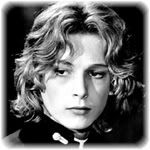Original News from Ghibli.world
I haven't yet seen the movie but well... not the least did I expect it to win the worst film + director ever!
21th of January, GEDO SENKI "WINNER" BUNSHUN RASPBERRY AWARD "WORST FILM 2006": Of course with all the great movies made by Studio Ghibli we’re often blessed with good Ghibli news. However, this time it’s not the case. Logboy, from the excellent film website Twitch, pointed me to a news item on Hoga Central about Japan's annual Bunshun Raspberry Awards. For those not familiar with these awards, they are given to the worst movies in the year selected by 32 movie critics in Japan. Unfortunately, Gedo Senki "won" the award for worst movie, as well as Goro Miyazaki "winning" the award for worst director.
Monday, January 22, 2007
Friday, January 19, 2007
More on Aleksandr Petrov

Brief biography from wiki:
Petrov was born in the village Prechistoye (Yaroslavl Oblast) and lives in Yaroslavl.
He had studied art, in particular at VGIK (State institute of the cinema and TV). He was a disciple of Yuriy Norshteyn in Advanced School for screenwriters and directors (Moscow).
After making his first films in Russia, in Canada he adapted the novel The Old Man and the Sea, resulting in a 20 minute long animated short — the first large-format animated film ever made. Technically impressive, the film is made entirely in pastel oil paintings on glass, a technique mastered by only a handful of animators in the world. By using his fingertips instead of a paintbrush on different glass sheets positioned on multiple levels, each covered with slow-drying oil paints, he was able to add depth to his paintings. After photographing each frame painted on the glass sheets, which was four times larger than the usual A4-sized canvas, he had to slightly modify the painting for the next frame and so on. It took Alexandr Petrov over two years, from March 1997 through April 1999, to paint each of the 29,000+ frames. For the shooting of the frames a special adapted motion-control camera system was built, probably the most precise computerized animation stand ever made. On this an IMAX camera was mounted, and a video-assist camera was then attached to the IMAX camera. The film was highly rewarded, receiving the Academy Award for the best animated short and Grand Prix at the Annecy International Animated Film Festival. After this, Alexandr Petrov has maintained a close relationship with Pascal Blais Studio in Canada, which helped fund The Old Man and the Sea, where he works on commercials. He returned to Yaroslavl in Russia to work on his latest film, My Love, which was finished in spring 2006 after three years' work and had its premiere at the Hiroshima International Animation Festival on August 27, where it won the Audience Prize and the Special International Jury Prize.
Petrov's style (from the late 1980s onward) can be characterized as a type of Romantic realism. People, animals and landscapes are painted and animated in a very realistic fashion, but there are many sections in his films where Petrov attempts to visually show a character's inner thoughts and dreams. In The Old Man and the Sea, for example, the fisherman dreams that he and the marlin are brothers swimming through the sea and the sky. In My Love, the main character's illness is represented by showing him being buried beneath freshly-fallen snow on a dark night. There are many other examples as well.
Films
director
«MARATHON» (1988)
«THE COW» (1989)
«DREAM OF A RIRDICULOUS MAN» (1992)
«THE WATER-NYMPH» (1996)
«THE OLD MAN AND THE SEA» (1999)
script writer
«THE COW» (1989)
«DREAM OF A RIRDICULOUS MAN» (1992)
«THE OLD MAN AND THE SEA» (1999)
art director
«BY A WAVE OF THE WAND» (1984)
«THE TALE ABOUT THE SMALL FRY» (1985)
«WELCOME!» (1986)
«THE GUARDIAN» (1989)
«DREAM OF A RIRDICULOUS MAN» (1992)
Thidwick the Big-Hearted Moose (wiki entry)
- 1986 paint on glass animated
- Directed by Alexei Karayev and art by Aleksandr Petrove
- Won Grand Prix at Ottawa International Animation Festival (1988)
THE OLD MAN AND THE SEA
My Love(2006), website from Ghibli Museum
Wednesday, January 17, 2007
Aleksandr Petrov exhibit in Ghibli museum
Ghibli museum will be hosting an Aleksandr Petrov exhibition, with his latest film 'My love'. Aleksandr Petrov!! I was really excited to be reminded again of his masterpiece 'The old man and the sea'. The animation consists of finger painted glass frames in oil. Can you imagine drawing tens of hundreds of oil paintings?? and the old animator did it all by himself. The pictures look fleshy and dreamy. He's a real romantic who knows how to capture the dream states.
wiki entry
wiki entry
Sunday, January 07, 2007
Adventures of Tintin

Yesterday's wiki daily article is on Tintin which explains for this sudden spark of interest in researching into my vague memory. I once bought a T-shirt with the blue lotus cover imprinted on the back. Thought I threw it away after a house cleaning. I threw away a lot of things which I shouldn't. This's definitely one of the comics I'll appreciate much better as a twenty something. The wordiness and maturity of contents (maturity doesn't imply violence or sexual explicitness here!) were of little interest to me as a child. I can't quite imagine the amount of research behind the story telling if the author didn't in fact travel around himself. Here's some info from wiki. The full entry is here.
The Adventures of Tintin (French: Les Aventures de Tintin) is a series of Belgian comic books created by Belgian artist Hergé, the pen name of Georges Remi (1907–1983). The series first appeared in French in a children's supplement to the Belgian newspaper Le Vingtième Siècle on January 10, 1929. Set in a painstakingly researched world closely mirroring our own, The Adventures of Tintin presents a number of characters in distinctive settings. The series has continued as a favourite of readers and critics alike for over 70 years.
The hero of the series is the eponymous character, Tintin, a young Belgian reporter and traveller. He is aided in his adventures from the beginning by his faithful dog Snowy (Milou in French). Later, popular additions to the cast included Captain Haddock and other colourful supporting characters.
The success of the series saw the serialised strips collected into a series of albums, spun into a successful magazine and adapted for both film and theatre. The series is one of the most popular European comics of the 20th century, with translations published in over 50 languages and more than 200 million copies of the books sold to date.
The comic strip series has long been admired for its clean, expressive drawings in Hergé's signature ligne claire (footnote1) style. Engaging, well-researched plots straddle a variety of genres: swashbuckling adventures with elements of fantasy; mysteries; political thrillers; and science fiction. The stories within the Tintin series always feature slapstick humour, offset in later albums by sophisticated satire and political/cultural commentary.
Online Links
Tintin official site
Tintinologist.org
1. Ligne claire (French for "clear line") is a style of drawing pioneered by Hergé, the Belgian creator of The Adventures of Tintin. It is a style of drawing which uses clear strong lines which have the same thickness and importance, rather than being used to emphasize certain objects or be used for shading (for this reason it is sometimes also called the democracy of lines). Additionally, the style often features strong colours and a combination of cartoonish characters against a realistic background. The use of shadows is sparse and all elements of a panel are delineated with clear black lines. The name was coined by Joost Swarte in 1977.
Hergé started out drawing in a much looser, rougher style which was influenced partially by the famous American comic strip artists of the late 1920s and 1930s. It was only after World War II that his drawing style evolved into ligne claire. For Hergé, the style was not limited to the drawings but extended to the story: the plot must be straightforward.
Subscribe to:
Posts (Atom)










































































